Good morning everyone, and welcome back to the Mirror Gallery here on Hipsters of the Coast for our last Grand Art Tour of 2021! The release of Innistrad: Crimson Vow is just around the corner, and that looming wedding day affords the perfect opportunity to dive deep into a set full of brand new artwork. This is Part II of our third trip to Innistrad; we’ve moved out of the woods of the Harvestide Festival and indoors to a grand affair of matrimony between two of the oldest vampire families on the plane. The event has the entire world in uproar, and has called Planeswalkers from across the Multiverse. The result is a mix of terror and beauty like we’ve never seen before.
As always, my Grand Art Tour series was inspired by New York Magazine art critic Jerry Saltz and his 2010 article called A Grand Tour. That original article was a short trip through the museums of New York City from that summer, illuminating his favorite works of art and the stories they told, and this latest Grand Tour will do the same through Magic’s most recent set. Stories abound, unseen at card size, and secret relationships hide within the frame, unapparent outside of the lens of criticism..
As I sometimes like to do, this Grand Art Tour will take a bit of a different format. The crux of this visit to Innistrad has been based on pairs: two sets, Day and Night, flip cards, and most recently now Bride and Groom; in short, there are two very different existences on Innistrad. As such, I’ve drawn pairs of work together, to compare and contrast our way across this land, and each group paints a larger picture about art, artist and the meaning we can draw from this oeuvre.
So let’s count by twos as we approach the alter, and look at some of my favorite works from Innistrad: Crimson Vow.
Chandra, Dressed to Kill & Eruth, Tormented Prophet by Ekaterina Burmak
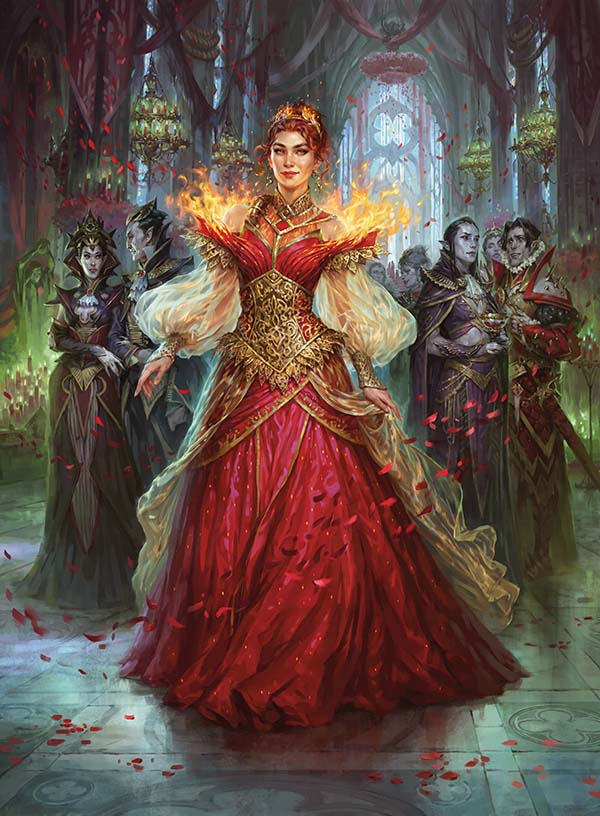
Chandra, Dressed to Kill by Ekaterina Burmak. Digital.
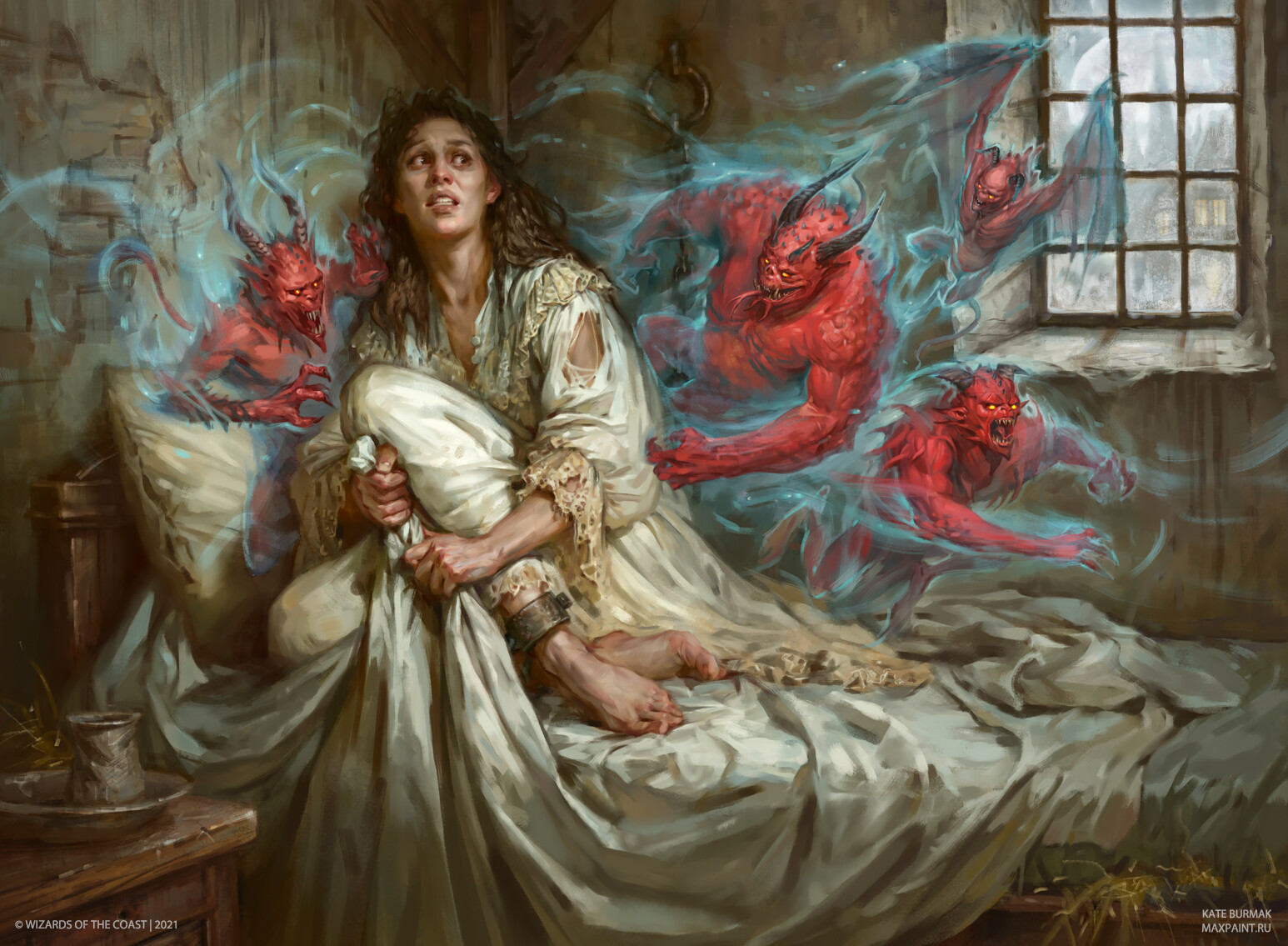
Eruth, Tormented Prophet by Ekaterina Burmak. Digital.
Kate Burmak’s figures are amongst the best in all of Magic; her latest pair of paintings simply take your breath away, and both in different ways. There is so much detail packed into both of these works and yet they’re legible on every level of narrative, and both at card size and full resolution.
Chandra, Dressed to Kill is one of Magic’s most recognizable faces redressed into incredible glamour, a look to be loved by cosplayers and collectors alike. And Erith, a new legend, is undergoing unspeakable torment, with all the anguish and misfortune without being overly gruesome. These paintings are a flawless rendering of the dichotomy of life on Innistrad, a literal look at how the other half lives.
Curse of Hospitality & Gift of Fangs by Dominik Mayer
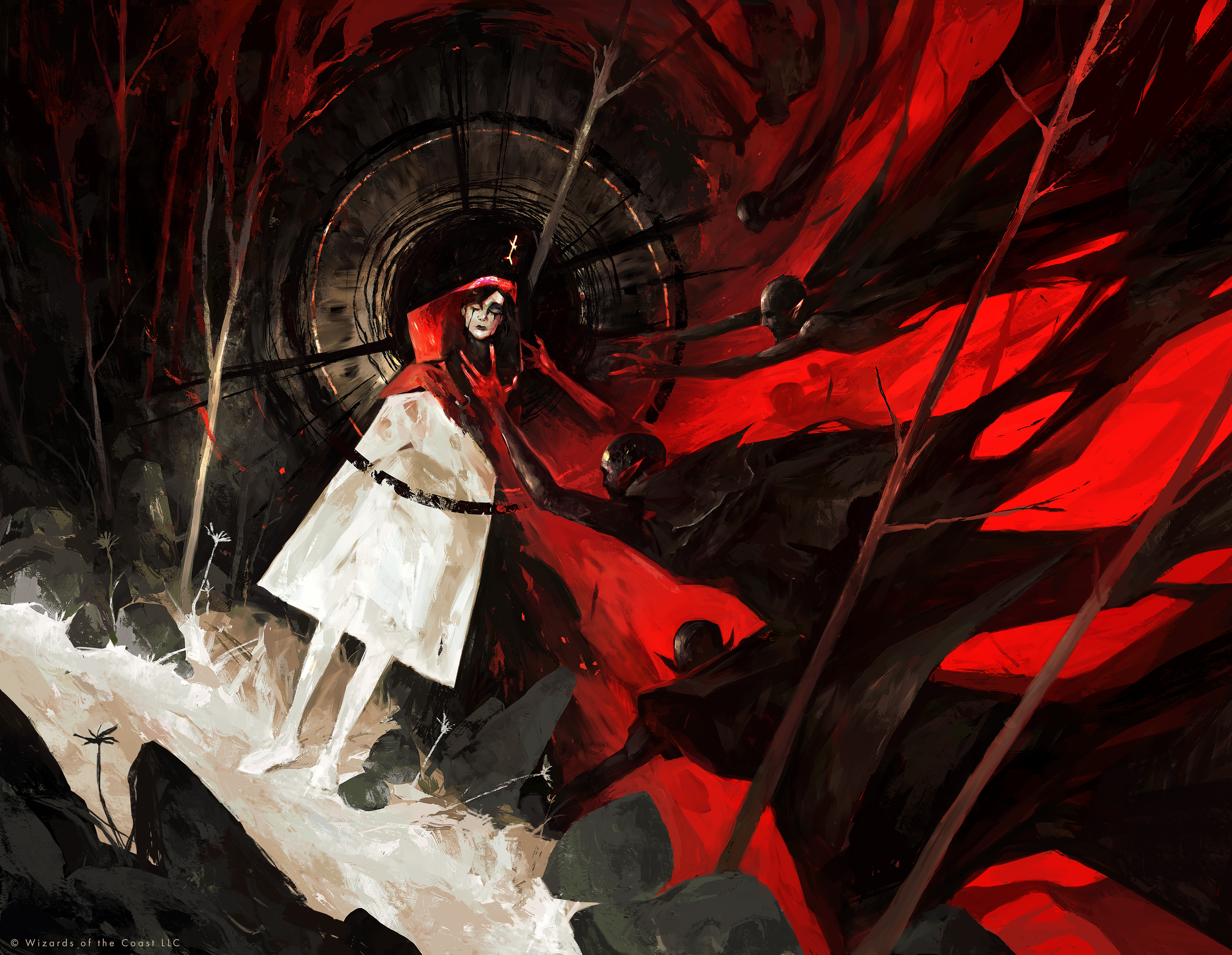
Curse of Hospitality by Dominik Mayer. Digital.
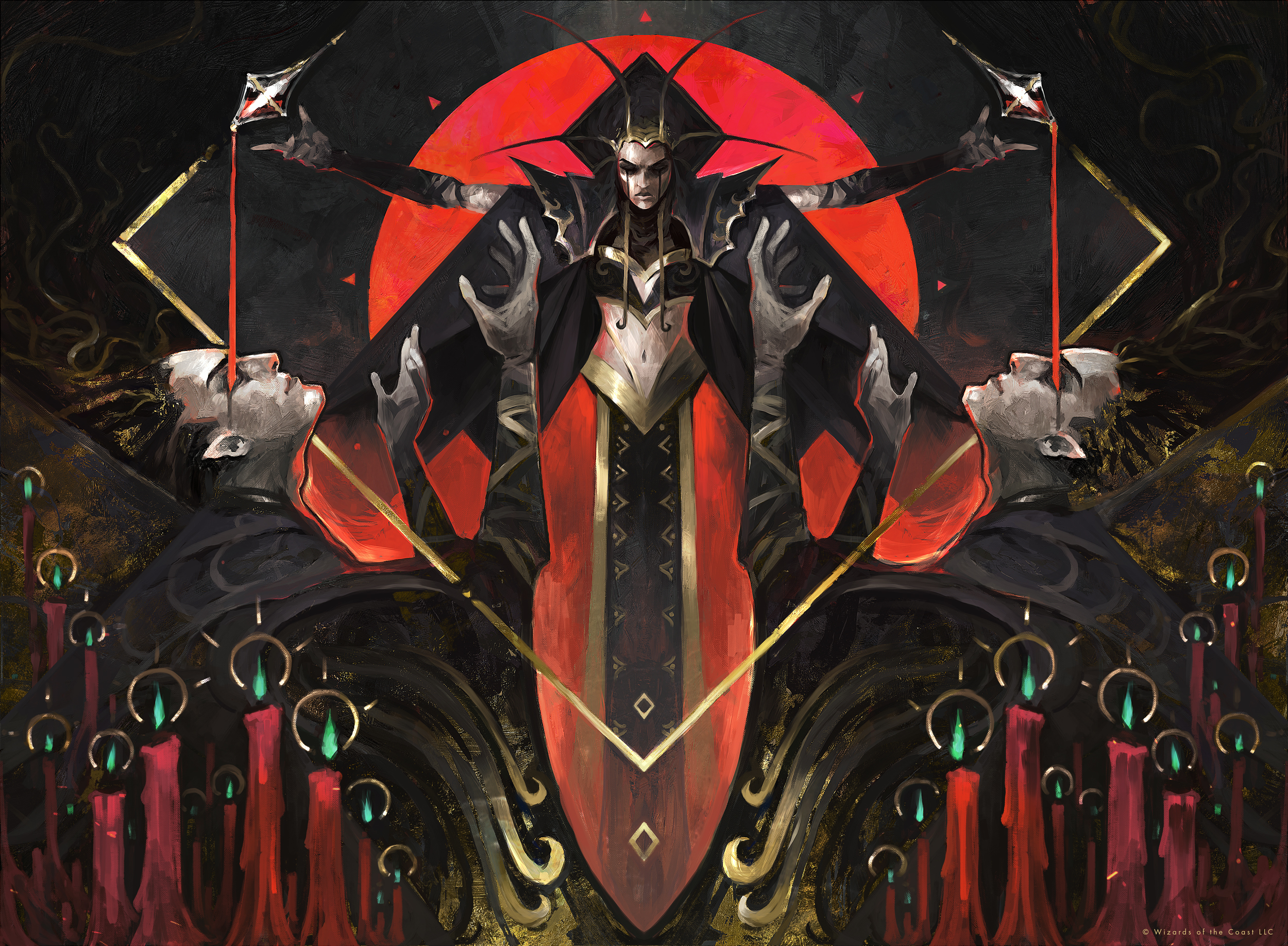
Gift of Fangs by Dominik Mayer. Digital.
We see several times in Crimson Vow work from artists tapped in the past only for alternate, showcase, or other special series artwork, now being featured within a “main” set. One of the most striking contributions is that of Dominik Mayer. His first cards appeared in last year’s Zendikar Rising showcase and Secret Lair, he returned for the Mystical Archive of Strixhaven: School of Mages, and now appears, for the first time, in the regular set of Crimson Vow without having to sacrifice any of his signature style.
Of his five new cards I think these two capture the essence of each side of Innistrad. Curse of Hospitality is a surrealist rendition of Little Red Riding Hood and the Big Bad Wolves, and Gift of Fangs a literal reflection of life as a Vampire on Innistrad, all contained within the same larger group of artwork. Mayer is a brilliant addition to Magic on the whole, and I hope that this means he’ll be a regular inclusion on sets, regardless of nature, moving forward.
Change of Fortune & Demonic Bargain by Sam Guay
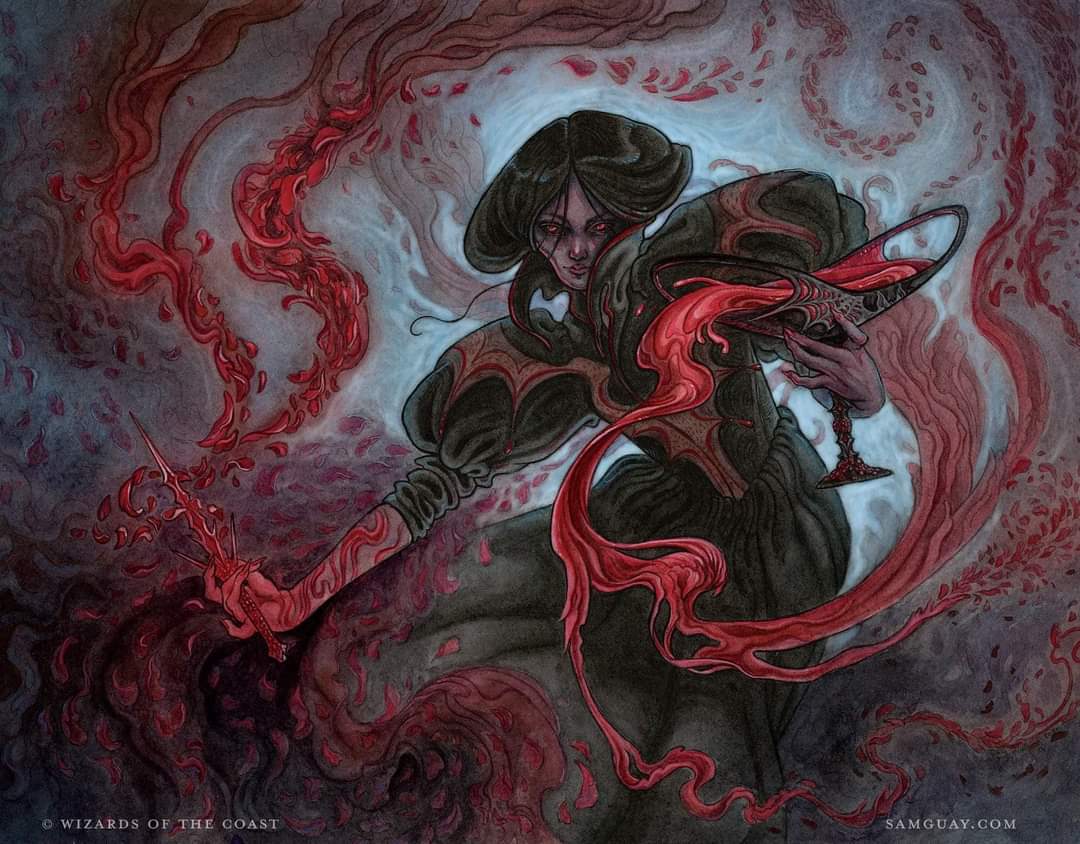
Change of Fortune by Sam Guay, watercolor, acryla-gouache, colored pencil and ink on hotpress watercolor paper, 11.5″ x 15”
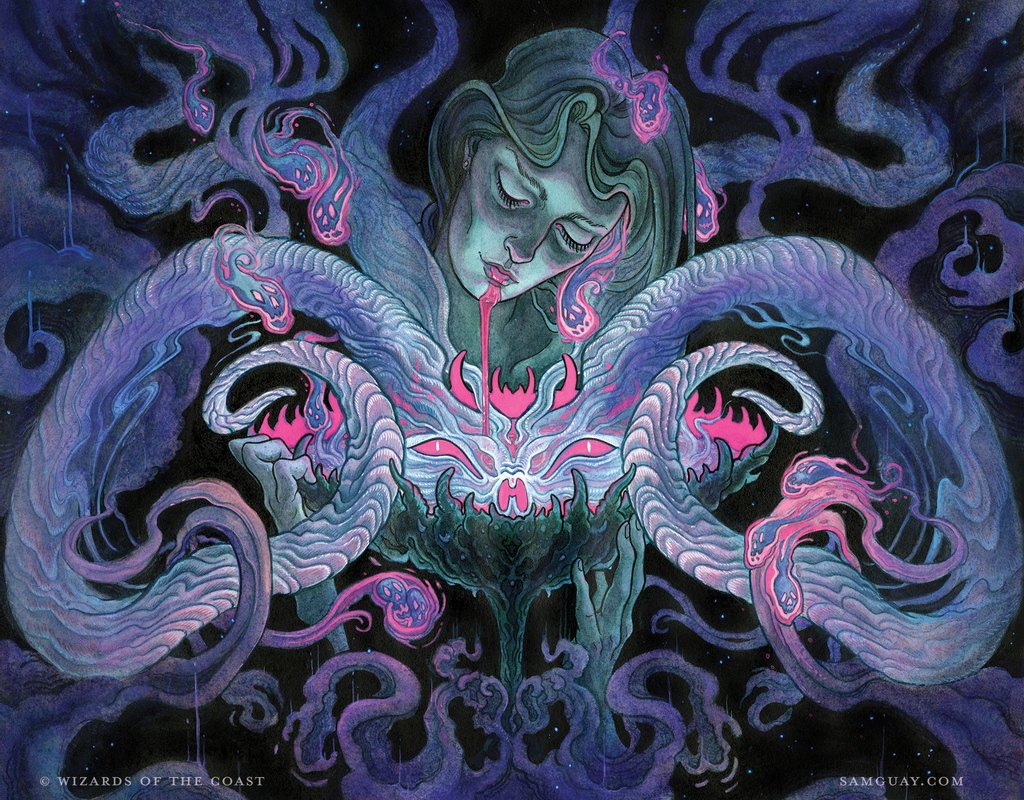
Demonic Bargain by Sam Guay, Traditional.
These are not Sam Guay’s first cards for Magic, but I think these are the full realization of the artist’s style appearing on a Magic card. Their art is the result of a communion between dark fantasy and the natural world, resulting in a storybook-esque folklore that is simply a magical fit for this game of Magic.
The undulating spells and almost neon colors of Change of Fortune and Demonic Bargain are fully realized in the Extended Art frame, and I literally cannot wait to see these in foil. Sam’s is knocking the cover off, and they have cemented their place here amongst some of the best.
Child of the Pack by Mila Pesic & Kessig Wolfrider by Bram Sels
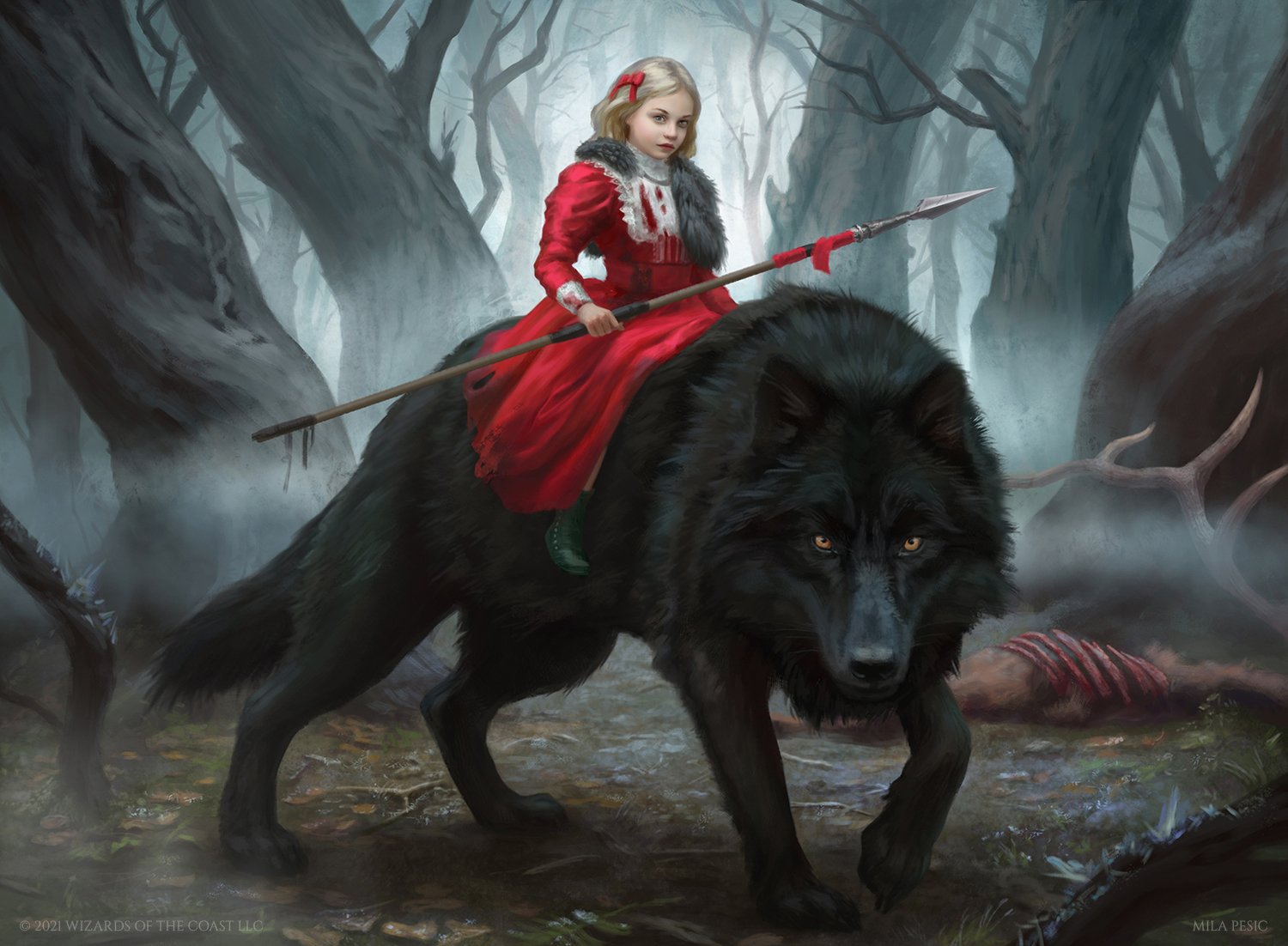
Child of the Pack by Mila Pesic. Digital.
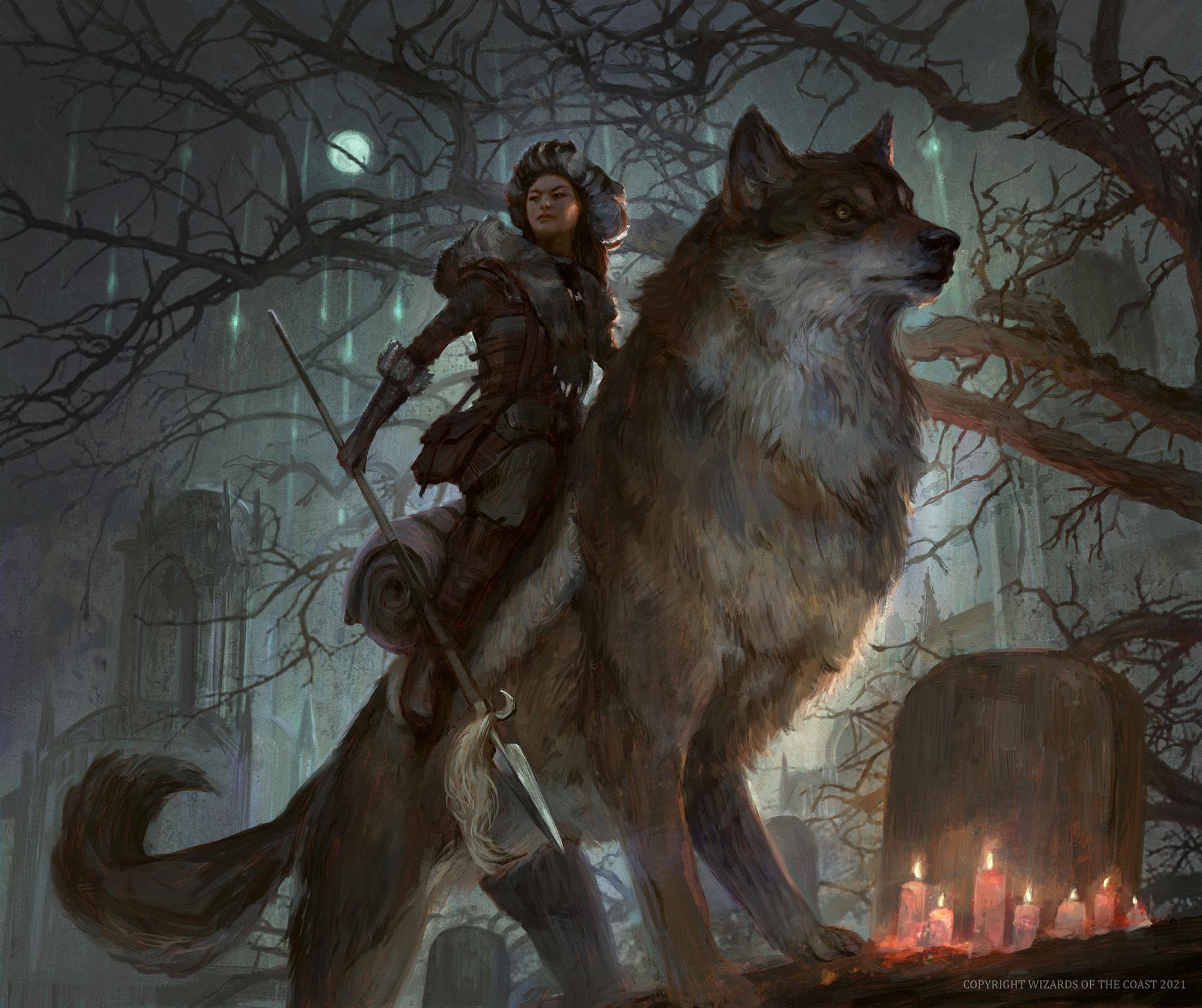
Kessig Wolfrider by Bram Sels. Digital.
Just because this new set is focused on Vampires doesn’t mean the wolves of Midnight Hunt have been forgotten. The juxtaposition of these two works shows us a lineage, almost a glimpse into the future. Child of the Pack is the story of a girl that is one with her wolf, and a far cry from what that child could become if the Eternal Night should continue. But Kessig Wolfrider is the foreshdowed conclusion, the relationship is realized if all is restored and a stoic symbiosis that creates our heroine into the protector, as opposed to that which needs protection from.
While this story may be contrived entirely within my head from two completely different artists, this set is full of these tiny narratives, if only you look closely.
Cartographer’s Survey by Donato Giancola & Consuming Tide by Viko Menzes
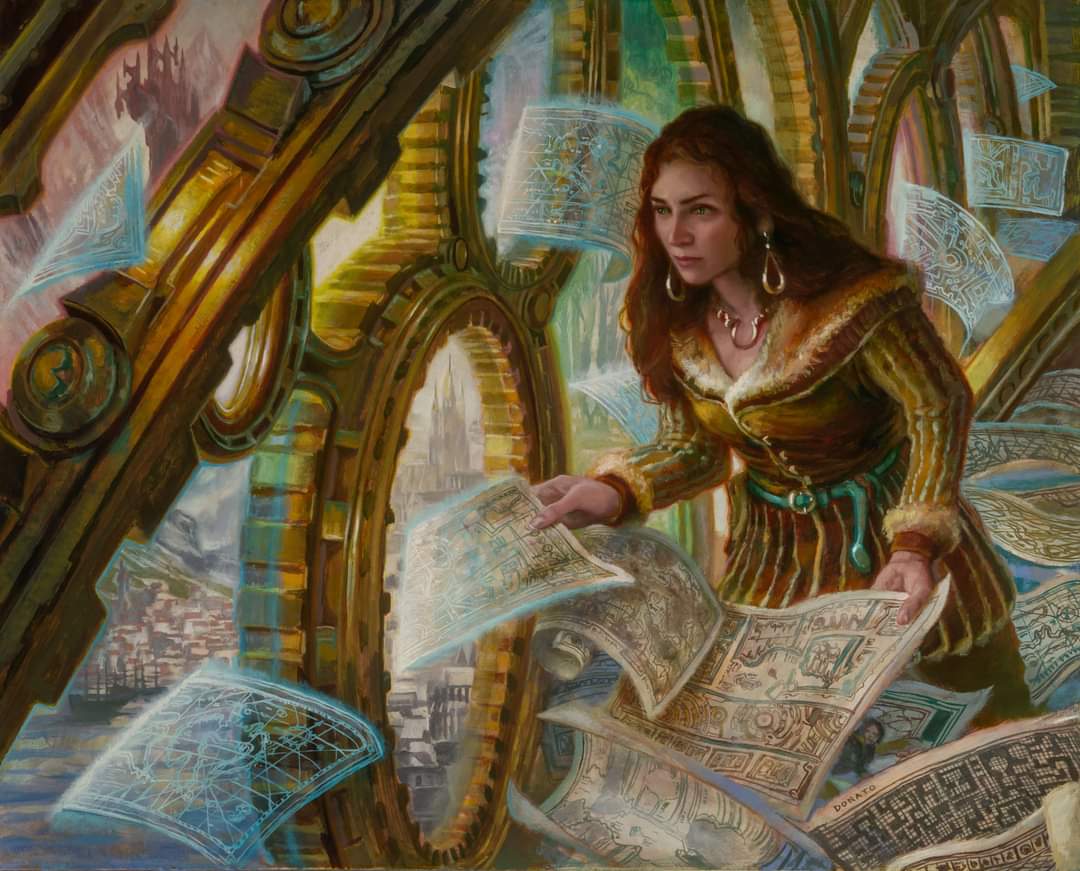
Cartographer’s Survey by Donato Giancola, oil on panel, 16” x 20”
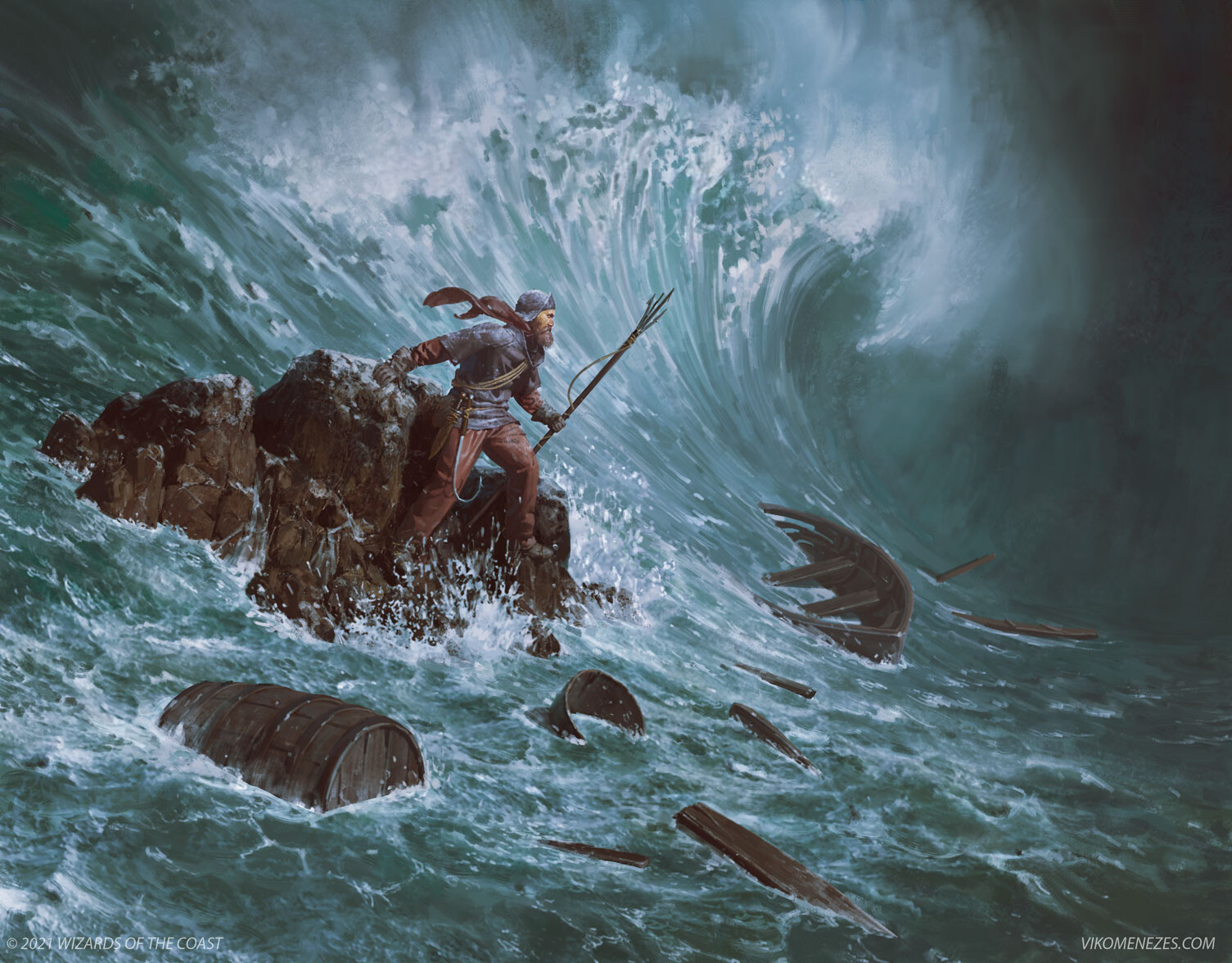
Consuming Tide by Viko Menezes. Digital.
These were two works on my initial short-list, but I hadn’t been able to find exactly where they fit into this overall review. That was until a late-night phone conversation with Vorthos Mike drew my eye to the bottom corner of Cartographer’s Survey, and the place known as Nephalia.
Nephalia is the coastal port-town province that is all but forgotten in these two sets, as it is neither Werewolf or Vampire, and only visible in backgrounds and portholes sprinkled throughout the two settings. But in Crimson Vow we get the two polar opposite of what Nephalia means to Innistrad. Donato’s paintings take us inside the artisan-cartographer’s workshop, a brilliant and glorious respite from the rain and rising tide of the outside. The latter is a scene fully realized in Menezes’s Consuming Tide on the right. Both of these worlds are Nephalia, a place that so desperately calls for more story and study. Expect that from Mike in the future.
Dread Fugue & Parasitic Grasp by Rovina Cai
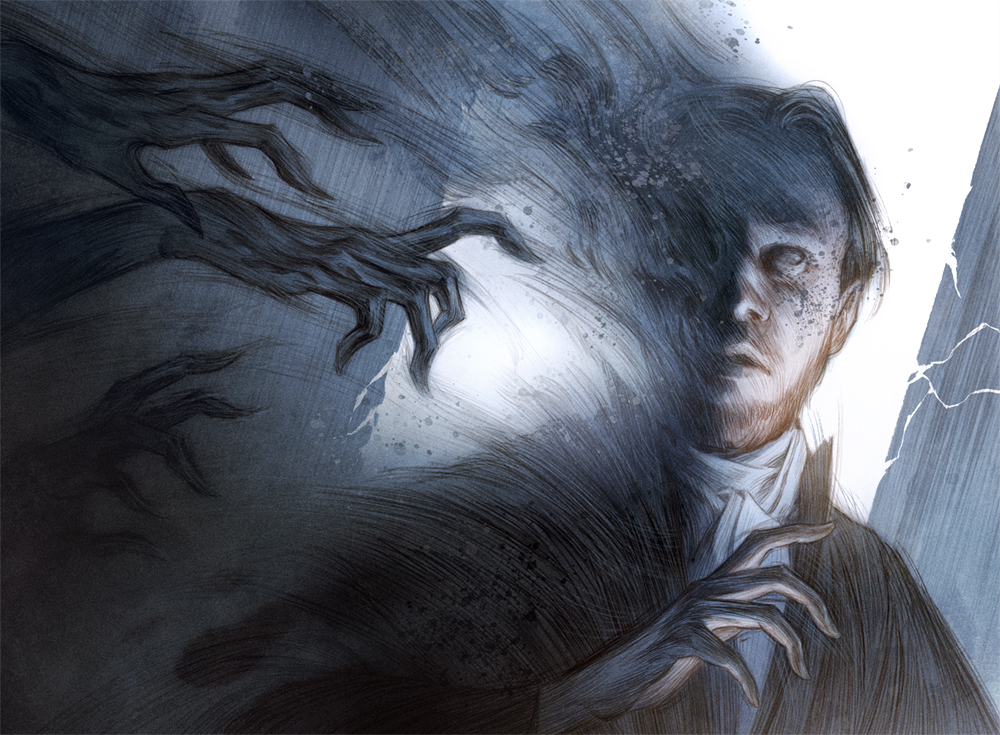
Dread Fugue by Rovina Cai. Digital
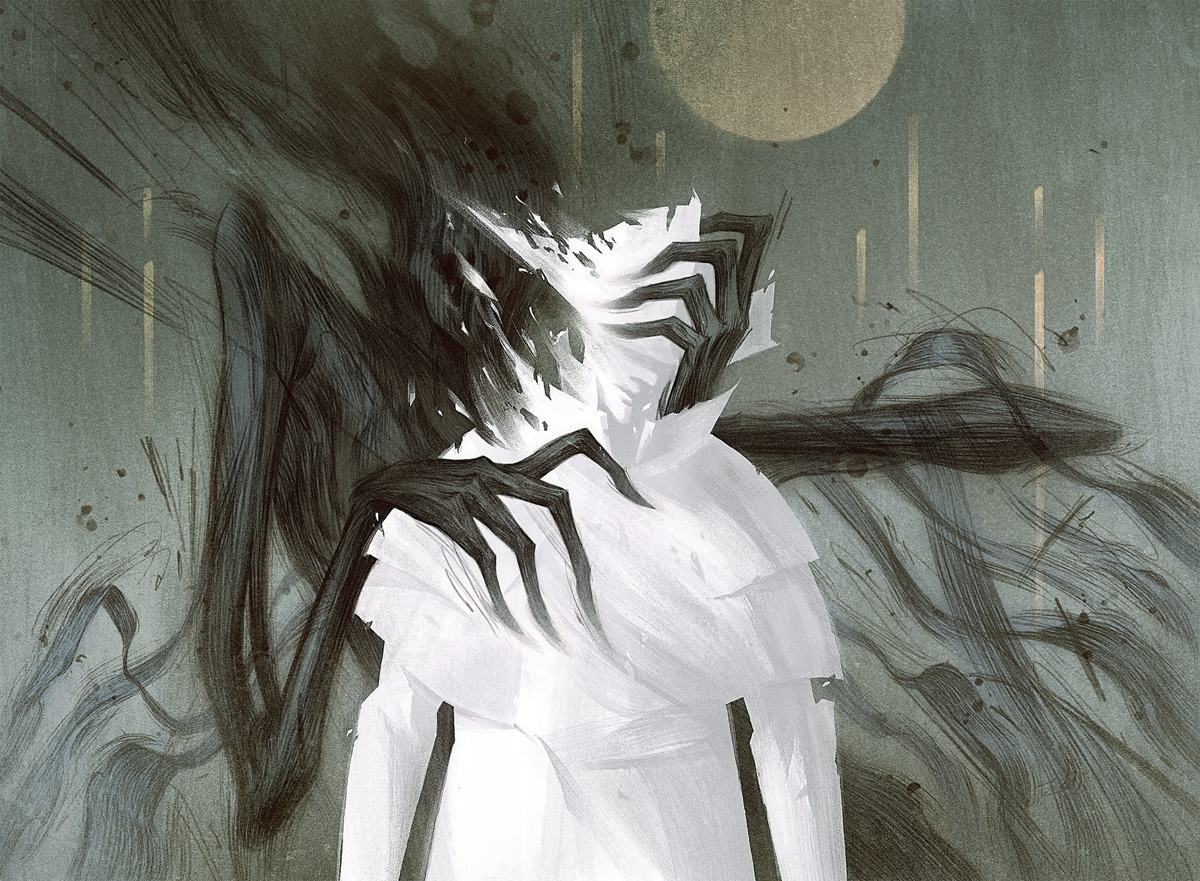
Parasitic Grasp by Rovina Cai. Digital.
Rovina Cai is one of most decorated artists in the genre, and her continuing work with Magic has also broken from the sphere of only “alternate art” and now is found in the main set as well. She’s given us two brand new and hauntingly beautiful images, and in each we see the wickedness of the world personified as a nightmare, preying upon the life on Innistrad.
Dread Fugue is the sound you hear as they’re coming, and Parasitic Grasp what happens once they’ve arrived. There is certain beauty in her simplicity and distinctness of style, and as in all her paintings, she’s telling wonderful and terrible stories, needing no words at all.
Runo Stromkirk & Krothuss, Lord of the Deep by Nico Delort
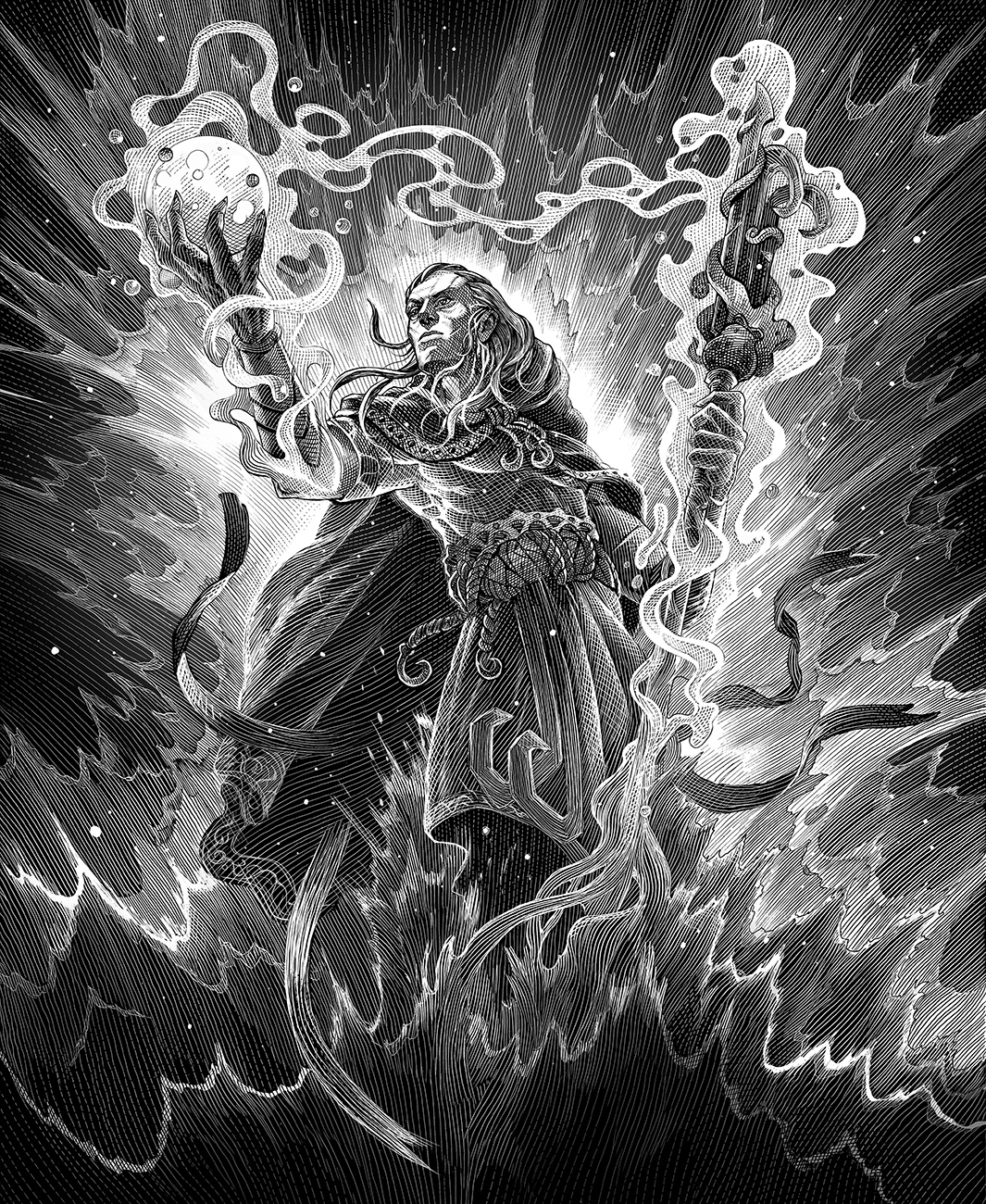
Runo Stromkirk by Nico Delort. Traditional Scratchboard, 24cm x 40cm
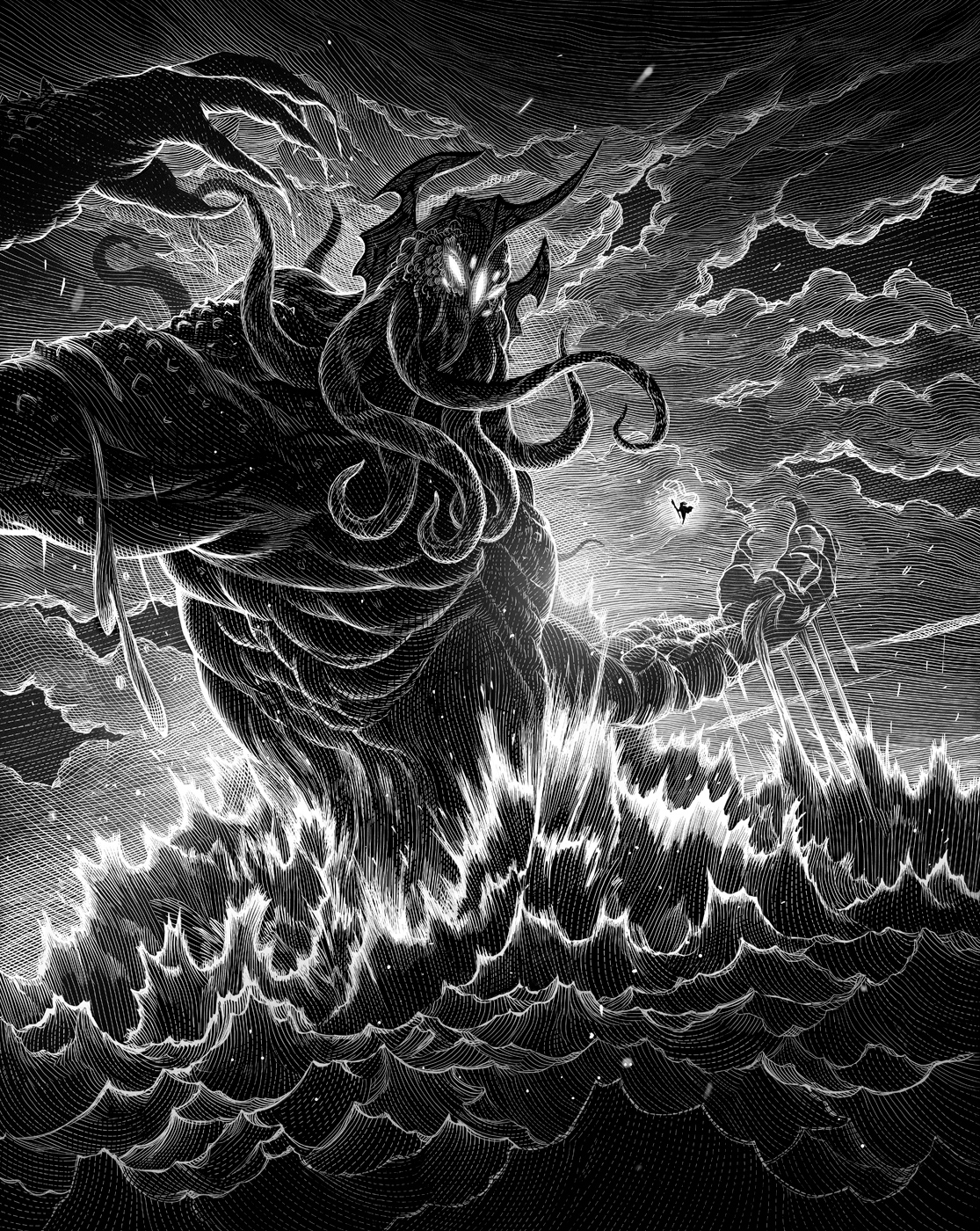
Krothuss, Lord of the Deep by Nico Delort. Traditional Scratchboard, 24cm x 40cm
I first mentioned Nico Delort’s work in my Kaldheim article featuring new artists that had come Magic, and he’s returned for the Eternal Night Showcase pair of Runo Stromkirk and the magnificent and monstrous kraken, Krothuss, Lord of the Deep.
Delort works by way of scratchboard, removing the medium and leaving the white of wavecrest and starlight in its place. Note the tiny details, from the smallest of hatch marks within Runo, to the progenitor of himself in miniature summoning the beast, both a massive statement of scale and an essential element that gives context to the tiny narrative. His style exemplifies the idea of the Eternal Night, and is the perfect addition to the Showcase set.
Massive Might by Iris Compiet & Bramble Wurm by Lars Grant-West
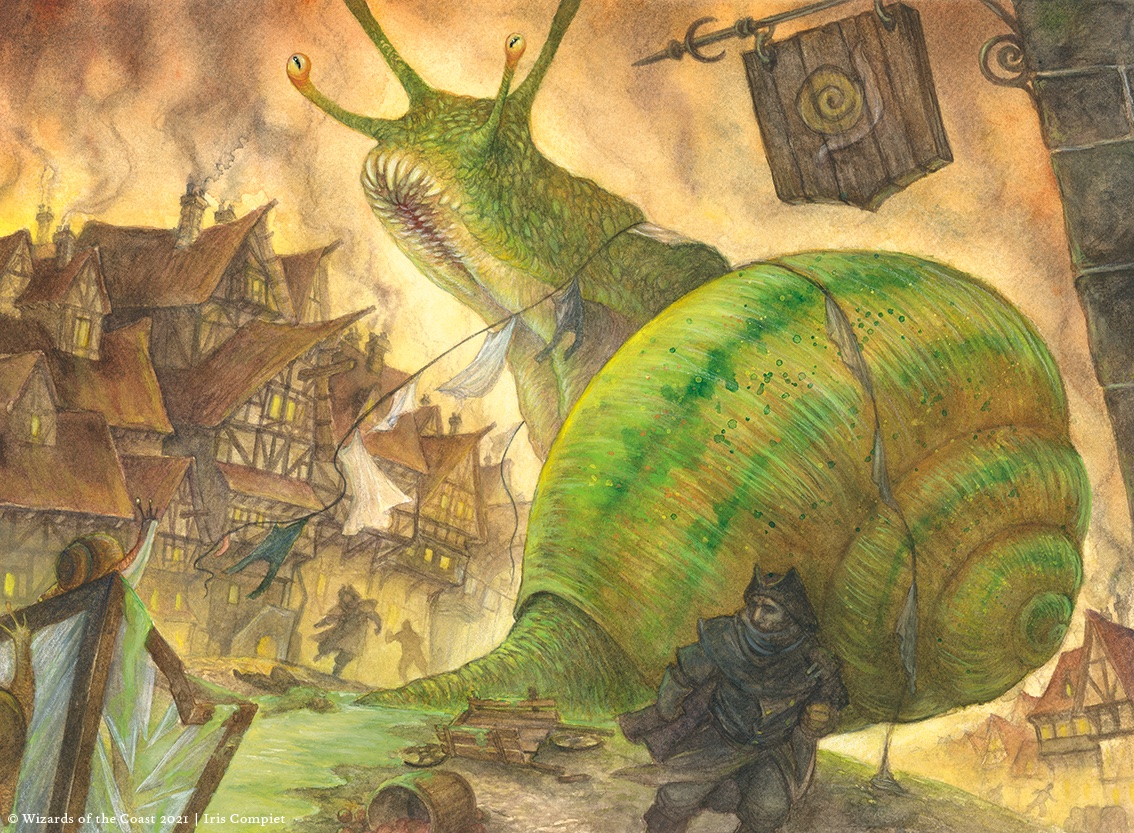
Massive Might by Iris Compiet, Traditional.
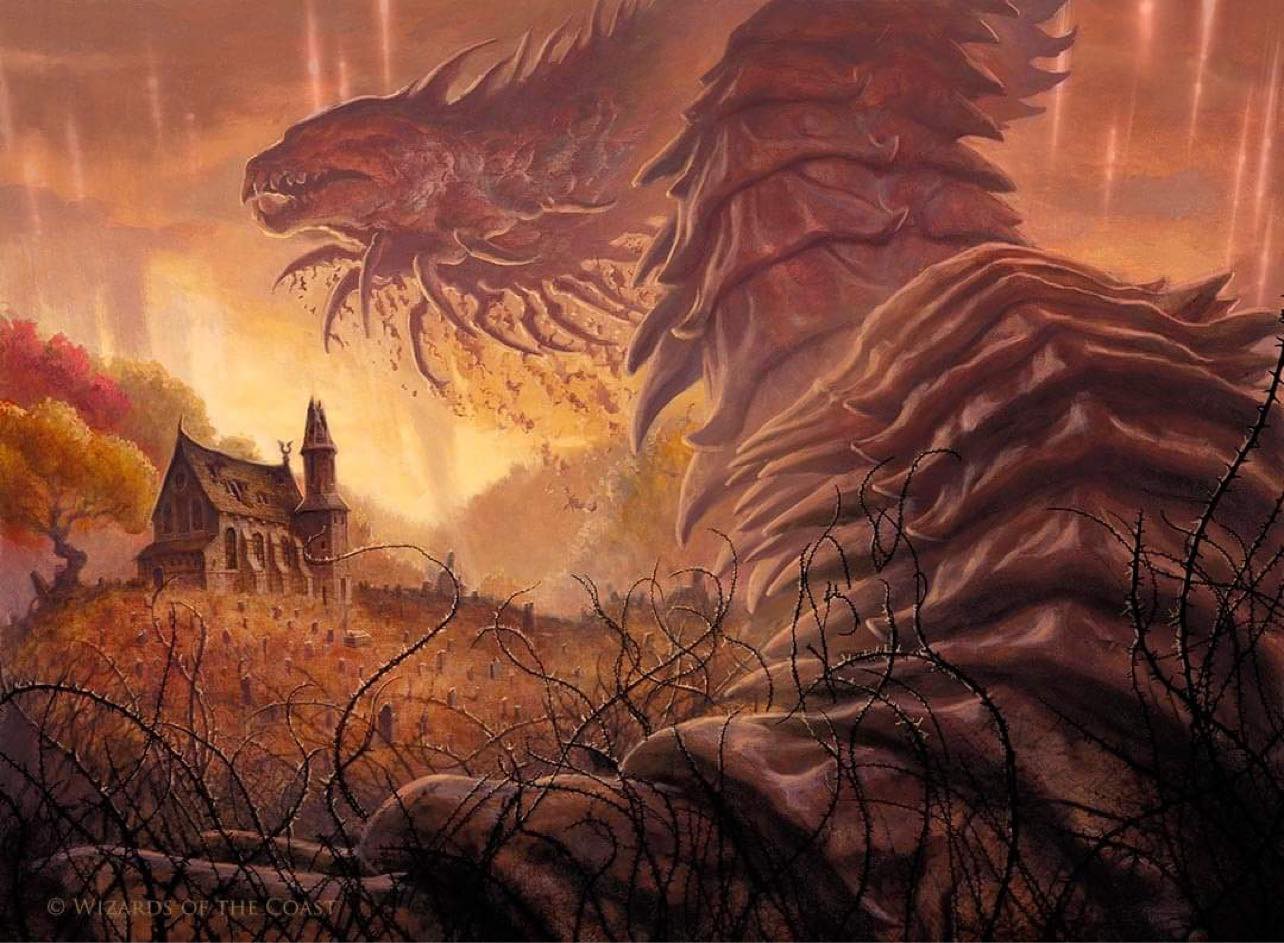
Bramble Wurm by Lars Grant-West. Traditional.
Speaking of scale, I love how these next two artists handled that very idea in two completely different ways. Iris Compiet is known for her storybook style, and in Massive Might shows a giant snail, larger than life itself, as it (slowly) makes its way through the villages of Havengul. Next to it, Lars Grant-West’s Bramble Wurm is an equally hulking creature, but the perspective has shifted, as we slither up the wurm to its head that hovers menacingly over a countryside home. Iris is telling us a tale as old as time, and Lars is forcing us into that very nightmare.
But even though the focus of both works is on something large, neither artist has forgotten those little bits of storytelling, even though they may not be visible at card size. Look at the sign on Massive Might; the ultimate irony as a snail all but destroys a snail shop. And then to the rooftop of the house about to fall prey to the wurm; the symbol of Avacyn: an entirely different sort of pray.
Halana and Alena, Partners by Joao Ruas
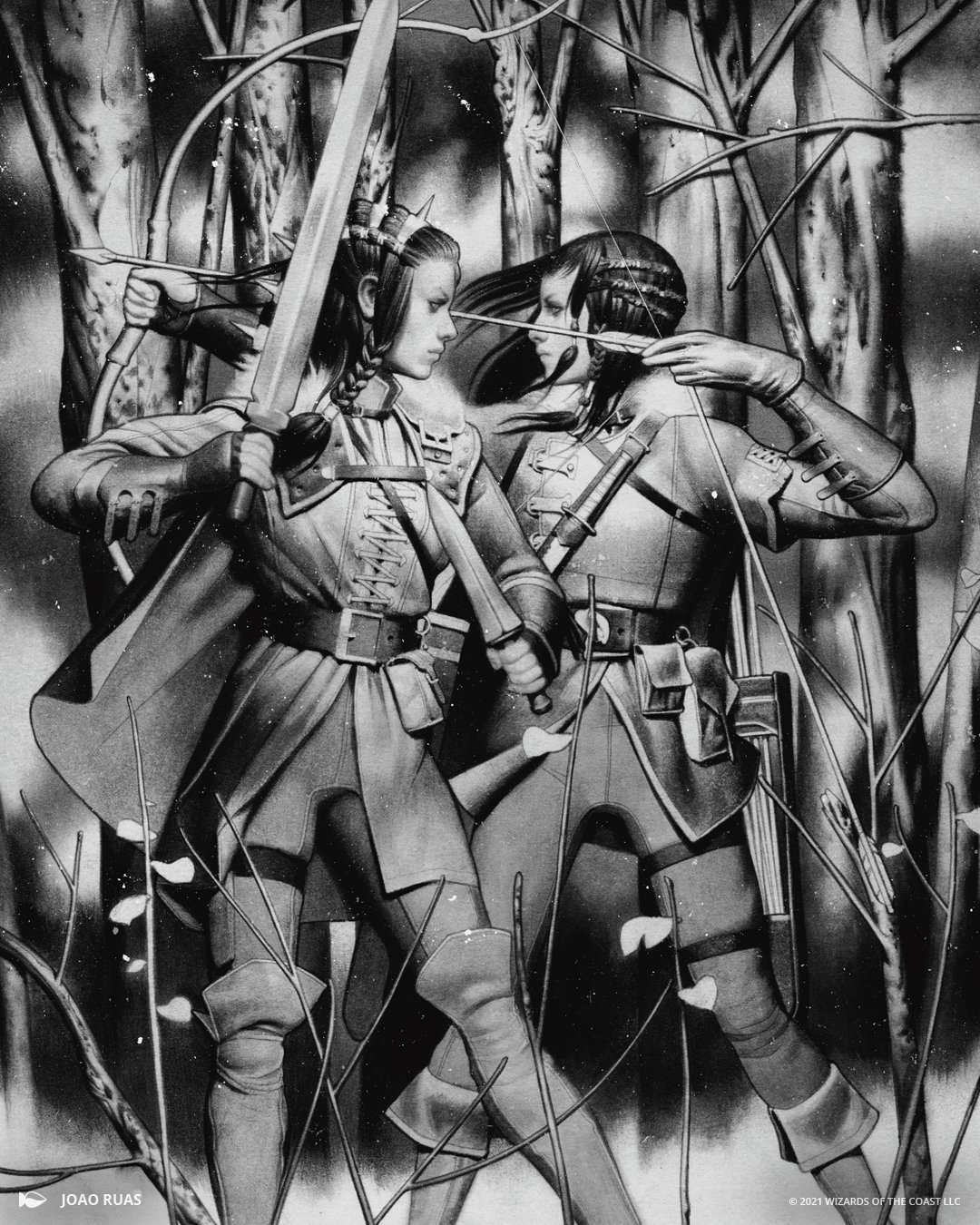
Halana and Alena by Joao Ruas. Digital
This is the only entry that isn’t two works, but rather two figures in a single work so poignant it needed to be included. It’s one of three works for Sao Paolo artist Joao Ruas in this set, and frames the famed rangers of Kessig, Halana and Alena, in a three dimensional style unique even to this black and white showcase.
Partners in work and in life, they square off opposite one another against the werewolves of the night. But if you look closely, you can see the slightest bit of eye contact, their gazes locked. It’s a tender moment against the gnashing of teeth deep within the Ulvenwald, felt even as a tiny piece of cardboard. Bravo, Joao.
Lucy Westenra & Lucy, Arisen Vampire by Igor Kierlyuk
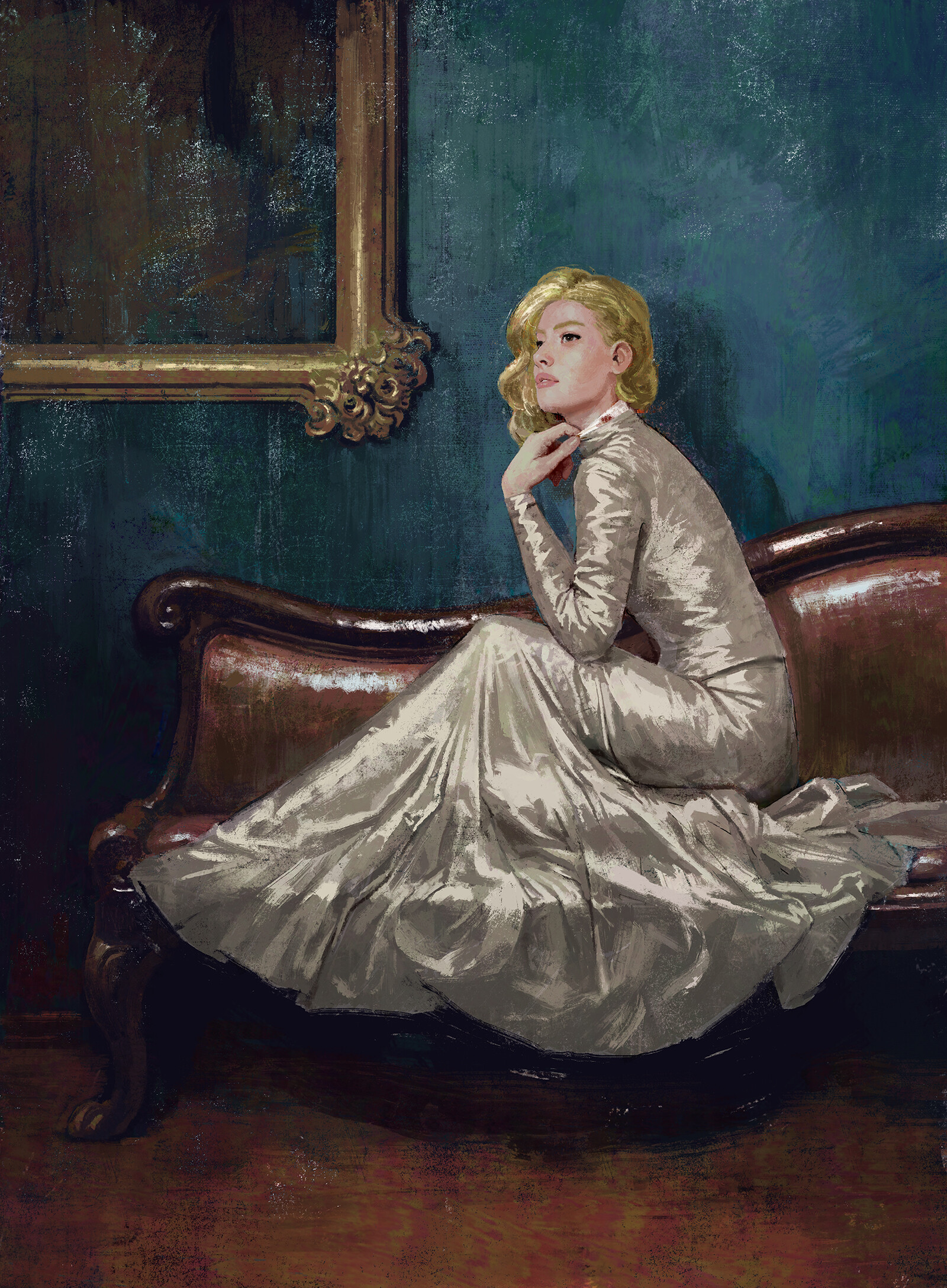
Lucy Westenra by Igor Kierlyuk. Digital.
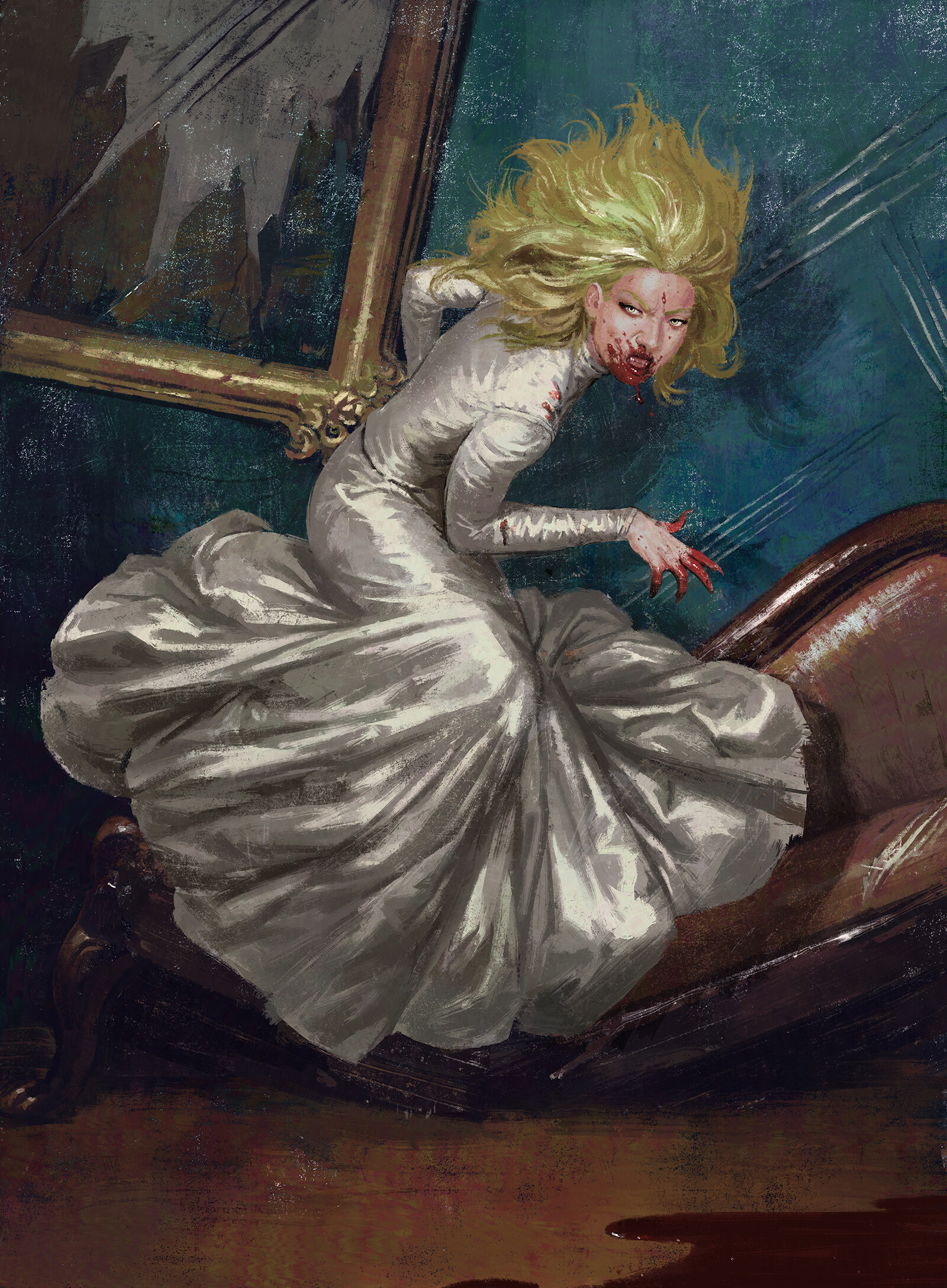
Lucy, Arisen Vampire by Igor Kierlyuk. Digital.
There is one more piece to Innistrad: Crimson Vow I’ve yet to mention, and that’s the Dracula series, which brings characters and places from the legendary novel and places them within the Magic multiverse on associated cards.
What if James Abbott MacNeill Whistler, in the years towards the end of his life, created a few final works of the characters of Bram Stoker’s Dracula? It is in that style that Igor Kierlyuk has brought us Lucy Westernra two different ways, both before and after the bite so to speak. As herself she is serene, solemn, and bears the subtle sexuality that is her ultimate demise. Flip the card and she becomes a woman unhinged within the same scene, the confines of the frame making her anger even more terrifying. These two artworks are yet another testament to Kierlyuk’s range as an artist, and a sure highlight of this new subseries.
Dragon Illusion by Andrew Mar & Spirit Cleric by Jarel Threat
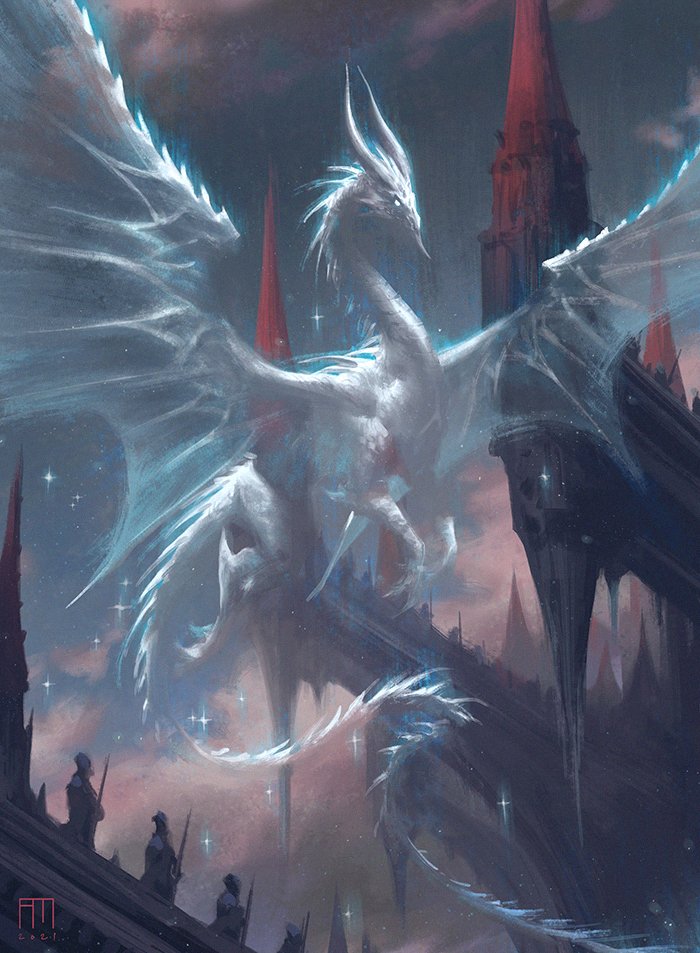
Dragon Illusion by Andrew Mar. Digital.
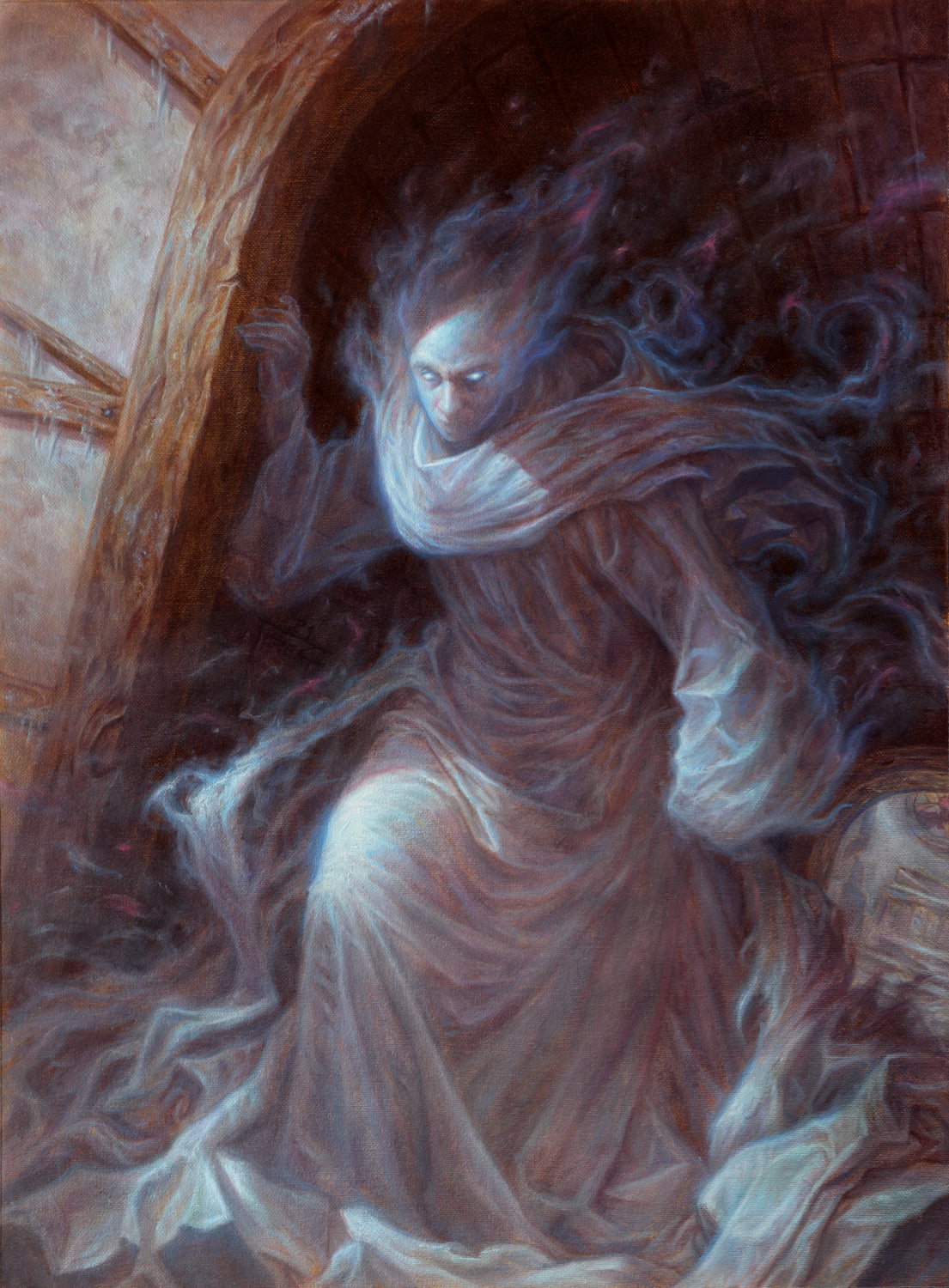
Spirit Cleric by Jarel Threat, oil on canvas, 14” x 19”
As a bit of a bonus, It’s not often that I get to include new token art in my Grand Tour, but these two works are cause for special exception as they are exemplary depictions of the spirit world as we see them on Innistrad. The Dragon Illusion is light and wispy, and yet commanding against a backdrop of stone and spire. Conversely, the Spirit Cleric has been given weight, humanizing the undead in a way only possible through a masterful rendering of drapery and cloth, and a technical feat as far as oil paint is concerned.
The artists did not have to go this hard on a token, but Andrew Mar and Jarel Threat are two meteoric rising stars in Magic, and they put out only their bets regardless of commission. Very, very well done.
Wrapping Up
And so ring the wedding bells that conclude our visit to Innistrad, and seals the Crimson Vow therein. Of all my Grand Art Tour articles, I think this one was perhaps the most expansive, pulling in work from the main set, borderless variations, each of the showcase subseries and even some tokens—all playing their own part in showing the breadth of what was trying to be communicated through the story’s artwork.
The two-set system of Innistrad was a strange return for modern Magic: parallel storylines that converge into a single world, and more than 700 pieces of artwork to go along. It’s created a rich revisitation to a world that, although we’ve visited so many times, feels as if we’ve barely scraped the surface this go-around. I long for the art books that once accompanied these sets as world guides, to dive in and hear every nuance, and hope that at some point in the future they’ll return as a residence for all the work that goes into these sets.
Remember, to see original #mtgart and other #vorthos related things, follow me on Twitter. Feel free to ask questions or retweet to continue the conversation. Thanks and see you next time!
Donny Caltrider has been playing Magic since 2002 and collecting original Magic art since 2017. He has an M.A. in Museum Studies from Johns Hopkins University and enjoys telling stories about art, objects, and the intersection of fantasy with real-life. You can find him on Twitter talking about #mtgart, museums, and other #vorthos related goodness. Follow along and continue the conversation!

